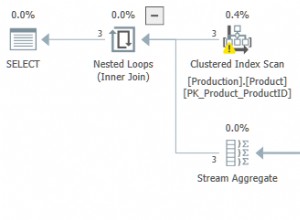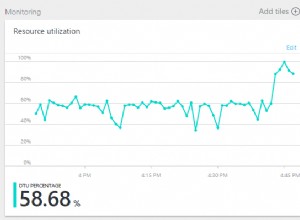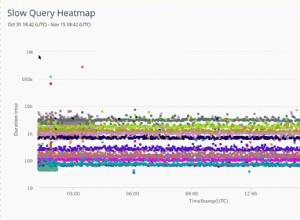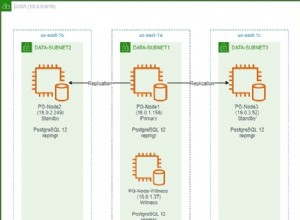Ho un'implementazione funzionante in cui faccio tutto all'interno di PostgreSQL senza librerie aggiuntive.
Funzione di analisi ausiliaria
CREATE OR REPLACE FUNCTION f_xml_extract_val(text, xml)
RETURNS text AS
$func$
SELECT CASE
WHEN $1 ~ '@[[:alnum:]_]+$' THEN
(xpath($1, $2))[1]
WHEN $1 ~* '/text()$' THEN
(xpath($1, $2))[1]
WHEN $1 LIKE '%/' THEN
(xpath($1 || 'text()', $2))[1]
ELSE
(xpath($1 || '/text()', $2))[1]
END;
$func$ LANGUAGE sql IMMUTABLE;
Gestisci multipli valori
L'implementazione di cui sopra non gestisce più attributi in un xpath. Ecco una versione sovraccaricata di f_xml_extract_val() per quello. Con il 3° parametro puoi scegliere one (il primo), all o dist valori (distinti). Più valori vengono aggregati in una stringa separata da virgole.
CREATE OR REPLACE FUNCTION f_xml_extract_val(_path text, _node xml, _mode text)
RETURNS text AS
$func$
DECLARE
_xpath text := CASE
WHEN $1 ~~ '%/' THEN $1 || 'text()'
WHEN lower($1) ~~ '%/text()' THEN $1
WHEN $1 ~ '@\w+$' THEN $1
ELSE $1 || '/text()'
END;
BEGIN
-- fetch one, all or distinct values
CASE $3
WHEN 'one' THEN RETURN (xpath(_xpath, $2))[1]::text;
WHEN 'all' THEN RETURN array_to_string(xpath(_xpath, $2), ', ');
WHEN 'dist' THEN RETURN array_to_string(ARRAY(
SELECT DISTINCT unnest(xpath(_xpath, $2))::text ORDER BY 1), ', ');
ELSE RAISE EXCEPTION
'Invalid $3: >>%<<', $3;
END CASE;
END
$func$ LANGUAGE plpgsql;
COMMENT ON FUNCTION f_xml_extract_val(text, xml, text) IS '
Extract element of an xpath from XML document
Overloaded function to f_xml_extract_val(..)
$3 .. mode is one of: one | all | dist'
Chiama:
SELECT f_xml_extract_val('//city', x, 'dist');
Parte principale
Nome della tabella di destinazione:tbl; primitivo. chiave:id :
CREATE OR REPLACE FUNCTION f_sync_from_xml()
RETURNS boolean AS
$func$
DECLARE
datafile text := 'path/to/my_file.xml'; -- only relative path in db dir
myxml xml := pg_read_file(datafile, 0, 100000000); -- arbitrary 100 MB
BEGIN
-- demonstrating 4 variants of how to fetch values for educational purposes
CREATE TEMP TABLE tmp ON COMMIT DROP AS
SELECT (xpath('//some_id/text()', x))[1]::text AS id -- id is unique
, f_xml_extract_val('//col1', x) AS col1 -- one value
, f_xml_extract_val('//col2/', x, 'all') AS col2 -- all values incl. dupes
, f_xml_extract_val('//col3/', x, 'dist') AS col3 -- distinct values
FROM unnest(xpath('/xml/path/to/datum', myxml)) x;
-- 1.) DELETE?
-- 2.) UPDATE
UPDATE tbl t
SET ( col_1, col2, col3) =
(i.col_1, i.col2, i.col3)
FROM tmp i
WHERE t.id = i.id
AND (t.col_1, t.col2, t.col3) IS DISTINCT FROM
(i.col_1, i.col2, i.col3);
-- 3.) INSERT NEW
INSERT INTO tbl
SELECT i.*
FROM tmp i
WHERE NOT EXISTS (SELECT 1 FROM tbl WHERE id = i.id);
END
$func$ LANGUAGE plpgsql;
Note importanti
-
Questa implementazione verifica su una chiave primaria se la riga inserita esiste già e aggiornamenti in questo caso. Vengono inserite solo nuove righe.
-
Uso una tabella di staging temporanea per velocizzare la procedura.
-
Testato con Postgres 8.4 , 9,0 e 9.1 .
-
XML deve essere ben formato.
-
pg_read_file()ha delle restrizioni. Il manuale:L'uso di queste funzioni è riservato ai superutenti.
E:
Solo file all'interno della directory del cluster di database e della
log_directorysi può accedere.
Quindi devi inserire il tuo file sorgente lì - o creare un collegamento simbolico al tuo file/directory attuale.
Oppure puoi fornire il file tramite Java nel tuo caso (ho fatto tutto all'interno di Postgres).
Oppure puoi importare i dati in 1 colonna di 1 riga di una tabella temporanea e prenderli da lì.
Oppure puoi usare lo_import come dimostrato in questa risposta correlata su dba.SE.
- SQL per leggere XML dal file nel database PostgreSQL
Questo post sul blog di Scott Bailey mi ha aiutato.




